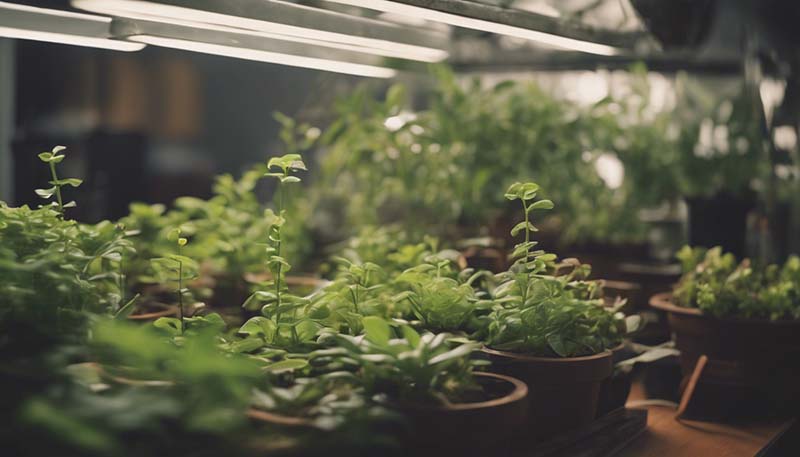Indoor gardening is a dynamic and evolving field, where understanding and controlling the environment are key to success. Carbon dioxide (CO2) is one of the most critical elements for plant growth, often becoming the limiting factor in indoor gardens where ventilation and space are limited. This article delves into the significance of CO2 in plant biology, how it impacts indoor gardening, and strategies to optimize its levels for healthier, more productive plants.
## The Importance of CO2 in Photosynthesis
### Photosynthesis: The Basis of Plant Growth
Photosynthesis is the process by which green plants and some other organisms use sunlight to synthesize foods with the help of chlorophyll pigments. It involves the conversion of light energy into chemical energy that can be later released to fuel the organisms' activities. The process can be summarized by the following equation:
Advertisement
\[ 6CO_2 + 6H_2O + light energy \rightarrow C_6H_{12}O_6 + 6O_2 \]
This equation represents the conversion of carbon dioxide and water into glucose and oxygen in the presence of light.
### CO2: A Key Ingredient
Carbon dioxide is a vital component of photosynthesis. It provides the carbon that plants need to construct the complex carbohydrates that serve as the basis for their growth and development. Without sufficient CO2, plants cannot reach their full growth potential.
## CO2 Levels in Indoor Environments
### Natural CO2 Concentration
The natural CO2 concentration outside is about 400 parts per million (ppm). However, inside a closed environment like a home, the CO2 levels can drop significantly, especially if the space is well-sealed and has limited air exchange with the outside.
### Impact on Plant Health
Low CO2 levels can stress plants and slow their growth, making indoor gardens less productive than they could be. To achieve optimal growth, many indoor gardeners supplement CO2 levels, aiming for concentrations between 800 and 1200 ppm during the day.
## Enhancing CO2 in Indoor Gardens
### Ventilation and Air Exchange
Before supplementing with CO2, it's crucial to ensure that the garden has adequate ventilation. Proper air circulation not only helps to dissipate heat but also to maintain a healthy balance of gases, including oxygen and CO2.
### CO2 Enrichment Methods
There are several methods to increase CO2 levels in an indoor garden:

1. **Dedicated CO2 Systems**: These systems use CO2 tanks or generators to release controlled amounts of CO2 into the growing area.
2. **Fertilizer Dispensers**: Some fertilizer dispensers can release CO2 as part of their nutrient solution.
3. **Exothermic Compounds**: Certain compounds, when heated, release CO2. These can be used in a controlled manner to increase CO2 levels.
4. **Natural Decay**: Organic matter that decomposes can release CO2, which can be harnessed in a closed system.
5. **Human Occupants**: Ironically, people are a natural source of CO2. Having people in the growing space can help raise CO2 levels, although this is not a reliable method for large-scale operations.
### Monitoring CO2 Levels
It's essential to monitor CO2 levels using a CO2 meter to ensure they are within the optimal range. Too much CO2 can lead to leaf discoloration and other issues, while too little will hinder growth.
## CO2 and Plant Health
### Enhanced Growth
An adequate supply of CO2 can lead to faster growth rates, increased yields, and improved overall plant health. It's common to see a significant difference in the vigor of plants when CO2 levels are properly managed.
### Nutrient Uptake
CO2 enrichment can also improve the uptake of nutrients. With more energy available from photosynthesis, plants can allocate more resources to nutrient absorption and utilization.
### Pest and Disease Resistance
Healthy plants are more resistant to pests and diseases. By optimizing CO2 levels, you can indirectly improve a plant's natural defenses.
## CO2 Management Best Practices
### Safety Considerations
It's crucial to remember that high concentrations of CO2 can be harmful to humans and pets. Always ensure that CO2 levels are kept within safe limits for humans (below 5000 ppm) and that there is a proper ventilation system in place.
### Light and CO2
CO2 enrichment should be paired with adequate lighting. Plants need light to photosynthesize, and without it, the additional CO2 will not be effectively utilized.
### Temperature Control
CO2 is less soluble in warmer water, which can affect the plant's ability to absorb it. Maintaining optimal temperatures can help maximize CO2 uptake.
### Ventilation and Circulation
Even with CO2 supplementation, it's important to ensure proper ventilation and air circulation to prevent the buildup of heat and other gases that can be harmful to plant growth.
## Conclusion
CO2 plays a critical role in the success of indoor gardens. By understanding how to manage CO2 levels effectively, gardeners can significantly improve plant growth, yield, and overall health. It's an aspect of indoor horticulture that, when properly addressed, can lead to bountiful harvests and a thriving indoor ecosystem.
Comment